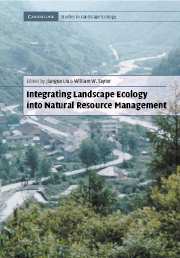Book contents
- Frontmatter
- Contents
- List of contributors
- Foreword
- Preface
- Acknowledgments
- PART I Introduction and concepts
- 1 Coupling landscape ecology with natural resource management: Paradigm shifts and new approaches
- PART II Landscape structure and multi-scale management
- PART III Landscape function and cross-boundary management
- PART IV Landscape change and adaptive management
- PART V Landscape integrity and integrated management
- PART VI Syntheses and perspectives
- Index
- Plate Section
1 - Coupling landscape ecology with natural resource management: Paradigm shifts and new approaches
Published online by Cambridge University Press: 14 January 2010
- Frontmatter
- Contents
- List of contributors
- Foreword
- Preface
- Acknowledgments
- PART I Introduction and concepts
- 1 Coupling landscape ecology with natural resource management: Paradigm shifts and new approaches
- PART II Landscape structure and multi-scale management
- PART III Landscape function and cross-boundary management
- PART IV Landscape change and adaptive management
- PART V Landscape integrity and integrated management
- PART VI Syntheses and perspectives
- Index
- Plate Section
Summary
Introduction
Global human population has now exceeded 6 billion people and this rapidly increasing population has significant implications for natural resources. On the one hand, demands for natural resources have dramatically increased and will continue to increase (FAO, 1997). On the other hand, natural resources have been reduced in both quantity and quality as extraction has become more intensive and extensive than ever before (Vitousek et al., 1997).As a result, much of the world's biodiversity has been lost (Ehrlich, 1988; Myers, 1990; Pimm and Gittleman, 1992), and many species have become threatened and endangered (Wilson, 1988; Rutledge et al., 2001). Other ecological consequences include degradation of ecosystem goods and services (Costanza et al., 1997; Daily, 1997), landscape fragmentation (Harris, 1984), and unsustainable use of natural resources (World Commission on Environment and Development, 1987; Lubchenco et al., 1991). Furthermore, the management of natural resources has become more constrained and complex due to the interactions among ecological, political, socioeconomic, demographic, and behavioral factors (Thrupp, 1990; Cairns and Lackey, 1992; FEMAT, 1993; Liu, 2001; McCool and Guthrie, 2001; Chapter 19, this book). In order to address these great challenges in natural resource management and to achieve sustainability of natural resources in the future (Speth, 1992; MacDonald, 1998; Rogers and Feiss, 1998; Kates et al., 2001), resource managers need insightful guidance and new perspectives from emerging disciplines such as landscape ecology (Sharitz et al., 1992; Swanson and Franklin, 1992; Noss, 1983; Dale et al., 2000).
Landscape ecology is an interdisciplinary field that studies landscape structure, function, and change (Forman and Godron, 1986; Hobbs, 1995).
- Type
- Chapter
- Information
- Publisher: Cambridge University PressPrint publication year: 2002
- 4
- Cited by



